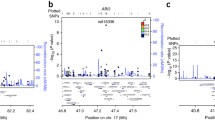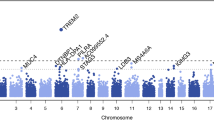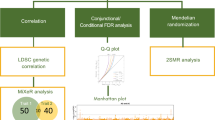Abstract
The existing large-scale genome-wide association studies (GWAS) datasets provide strong support for investigating the mechanisms of Alzheimer’s disease (AD) by applying multiple methods of pathway analysis. Previous studies using selected single nucleotide polymorphisms (SNPs) with several thresholds of nominal significance for pathway analysis determined that the threshold chosen for SNPs can reflect the disease model. Presumably, then, pathway analysis with a stringent threshold to define “associated” SNPs would test the hypothesis that highly associated SNPs are enriched in one or more particular pathways. Here, we selected 599 AD variants (P < 5.00E−08) to investigate the pathways in which these variants are enriched and the cell types in which these variants are active. Our results showed that AD variants are significantly enriched in pathways of the immune system. Further analysis indicated that AD variants are significantly enriched for enhancers in a number of cell types, in particular the B-lymphocyte, which is the most substantially enriched cell type. This cell type maintains its dominance among the strongest enhancers. AD SNPs also display significant enrichment for DNase in 12 cell types, among which the top 6 significant signals are from immune cell types, including 4 B cells (top 4 significant signals) and CD14+ and CD34+ cells. In summary, our results show that these AD variants with P < 5.00E−08 are significantly enriched in pathways of the immune system and active in immune cells. To a certain degree, the genetic predisposition for development of AD is rooted in the immune system, rather than in neuronal cells.


Similar content being viewed by others
References
Pedersen NL (2010) Reaching the limits of genome-wide significance in Alzheimer disease: back to the environment. JAMA 303:1864–1865
Lambert JC, Grenier-Boley B, Chouraki V, Heath S, Zelenika D, Fievet N, Hannequin D, Pasquier F et al (2010) Implication of the immune system in Alzheimer’s disease: evidence from genome-wide pathway analysis. J Alzheimers Dis 20:1107–1118
Liu G, Wang H, Liu J, Li J, Li H, Ma G, Jiang Y, Chen Z et al (2014) The clu gene rs11136000 variant is significantly associated with Alzheimer’s disease in Caucasian and Asian populations. Neuromolecular Med 16:52–60
Li Y, Song D, Jiang Y, Wang J, Feng R, Zhang L, Wang G, Chen Z, Wang R, Jiang Q, Liu G: Cr1 rs3818361 polymorphism contributes to Alzheimer’s disease susceptibility in Chinese population. Mol Neurobiol 2015
Lambert JC, Ibrahim-Verbaas CA, Harold D, Naj AC, Sims R, Bellenguez C, DeStafano AL, Bis JC et al (2013) Meta-analysis of 74,046 individuals identifies 11 new susceptibility loci for Alzheimer’s disease. Nat Genet 45:1452–1458
Bertram L, Lill CM, Tanzi RE (2010) The genetics of Alzheimer disease: back to the future. Neuron 68:270–281
Borovecki F, Klepac N, Muck-Seler D, Hajnsek S, Mubrin Z, Pivac N (2011) Unraveling the biological mechanisms in Alzheimer’s disease—lessons from genomics. Prog Neuropsychopharmacol B ol Psychiatry 35:340–347
Hong MG, Alexeyenko A, Lambert JC, Amouyel P, Prince JA (2010) Genome-wide pathway analysis implicates intracellular transmembrane protein transport in Alzheimer disease. J Hum Genet 55:707–709
Jones L, Holmans PA, Hamshere ML, Harold D, Moskvina V, Ivanov D, Pocklington A, Abraham R et al (2010) Genetic evidence implicates the immune system and cholesterol metabolism in the aetiology of Alzheimer’s disease. PLoS One 5:e13950
Liu G, Jiang Y, Wang P, Feng R, Jiang N, Chen X, Song H, Chen Z (2012) Cell adhesion molecules contribute to Alzheimer’s disease: multiple pathway analyses of two genome-wide association studies. J Neurochem 120:190–198
Convergent genetic and expression data implicate immunity in Alzheimer’s disease. Alzheimers Dement 2015;11:658–671
O’Dushlaine C, Kenny E, Heron EA, Segurado R, Gill M, Morris DW, Corvin A (2009) The snp ratio test: pathway analysis of genome-wide association datasets. Bioinformatics 25:2762–2763
Hindorff LA, Sethupathy P, Junkins HA, Ramos EM, Mehta JP, Collins FS, Manolio TA (2009) Potential etiologic and functional implications of genome-wide association loci for human diseases and traits. Proc Natl Acad Sci U S A 106:9362–9367
Kosova G, Scott NM, Niederberger C, Prins GS, Ober C (2012) Genome-wide association study identifies candidate genes for male fertility traits in humans. Am J Hum Genet 90:950–961
Loth DW, Artigas MS, Gharib SA, Wain LV, Franceschini N, Koch B, Pottinger TD, Smith AV et al (2014) Genome-wide association analysis identifies six new loci associated with forced vital capacity. Nat Genet 46:669–677
Zhang B, Kirov S, Snoddy J (2005) Webgestalt: an integrated system for exploring gene sets in various biological contexts. Nucleic Acids Res 33:W741–748
Ward LD, Kellis M (2012) Haploreg: a resource for exploring chromatin states, conservation, and regulatory motif alterations within sets of genetically linked variants. Nucleic Acids Res 40:D930–934
Gjoneska E, Pfenning AR, Mathys H, Quon G, Kundaje A, Tsai LH, Kellis M (2015) Conserved epigenomic signals in mice and humans reveal immune basis of Alzheimer’s disease. Nature 518:365–369
Huang Y, Skwarek-Maruszewska A, Horre K, Vandewyer E, Wolfs L, Snellinx A, Saito T, Radaelli E et al (2015) Loss of gpr3 reduces the amyloid plaque burden and improves memory in Alzheimer’s disease mouse models. Sci Transl Med 7:309ra164
Sollvander S, Ekholm-Pettersson F, Brundin RM, Westman G, Kilander L, Paulie S, Lannfelt L, Sehlin D et al (2015) Increased number of plasma b cells producing autoantibodies against abeta42 protofibrils in Alzheimer’s disease. J Alzheimers Dis 48:63–72
Spani C, Suter T, Derungs R, Ferretti MT, Welt T, Wirth F, Gericke C, Nitsch RM et al (2015) Reduced beta-amyloid pathology in an app transgenic mouse model of Alzheimer’s disease lacking functional b and t cells. Acta Neuropathol Commun 3:71
Acknowledgments
This work was supported by funding from the National Nature Science Foundation of China (Grant Nos. 81300945 and 61571152).
Author information
Authors and Affiliations
Corresponding author
Ethics declarations
Conflict of Interest
The authors reported no potential conflicts of interest.
Additional information
Qinghua Jiang and Shuilin Jin contributed equally to this work.
Electronic Supplementary Material
Below is the link to the electronic supplementary material.
Supplementary Table 1
(XLS 88 kb)
Supplementary Table 2
(XLS 250 kb)
Supplementary Table 3
(XLS 43 kb)
Rights and permissions
About this article
Cite this article
Jiang, Q., Jin, S., Jiang, Y. et al. Alzheimer’s Disease Variants with the Genome-Wide Significance are Significantly Enriched in Immune Pathways and Active in Immune Cells. Mol Neurobiol 54, 594–600 (2017). https://doi.org/10.1007/s12035-015-9670-8
Received:
Accepted:
Published:
Issue Date:
DOI: https://doi.org/10.1007/s12035-015-9670-8




